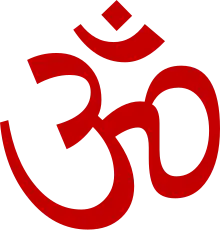曼怛羅
曼
| 印度教系列模板 |
| 印度教 |
|---|
 |
|
|

天城文的唵

西藏喇嘛用以冥想的在石头上刻的符咒
語源學
梵語中的“曼怛羅”來自原始印歐語mén-trom,其中“man”的意思是“思考”,後綴“tra”說明它是一種工具,因此“曼怛羅”的字面意思即“思考的工具”。[9][10] 它出現在公元前1000年以前。[11]
参考文献
- . [2020-06-07]. (原始内容存档于2020-06-07).
- 唐梵文字 (页面存档备份,存于):「(ma)(ntra)真言」
一行阿闍梨《大毘盧遮那成佛經疏》:「真言梵曰漫怛攞,即是真語、如語、不妄、不異之音。龍樹釋論謂之祕密號。舊譯呪,非正翻也。」 - 《唐梵翻對字音般若波羅蜜多心經》:「滿怛囉(呪)」
- 《般若波羅蜜多心經》(玄奘譯本):「故知般若波羅蜜多是大神咒」
- 《般若波羅蜜多心經》(法成譯本):「是故當知般若波羅蜜多大密咒者」
- 《根本說一切有部毘奈耶》:「當爾之時誦此伽他及禁呪者,不為蛇毒之所中害」
- Padoux, André. . G. Flood (编). . 2005.
- Harvey Alper (1989), Understanding Mantras, ISBN 81-208-0746-4, State University of New York, page 3-7
- Macdonell, Arthur A., A Sanskrit Grammar for Students § 182.1.b, p. 162(Oxford University Press, 3rd edition, 1927).
- Whitney, W.D., Sanskrit Grammar § 1185.c, p. 449(New York, 2003, ISBN 0-486-43136-3).
- Jan Gonda (1963), The Indian Mantra, Oriens, Vol. 16, pages 244–297
This article is issued from Wikipedia. The text is licensed under Creative Commons - Attribution - Sharealike. Additional terms may apply for the media files.